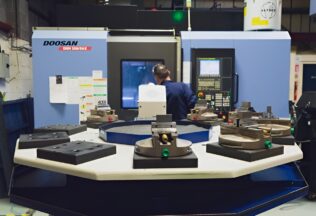Manufacturing Consultant’s Insights After Hundreds of Projects
Tim Grant, Founder of Business Solution Providers manufacturing consultancy, has spearheaded hundreds of software implementation projects. Here are some of the insights he’s gathered over the years.

Moving from accounting to manufacturing
Business Solutions Providers is a manufacturing consulting company from Nevada. The business was started in 2003 by accountant Tim Grant as a general accounting and bookkeeping service. After several years, however, Grant noticed that the needs of his supply chain and manufacturing clients weren’t well served by software vendors. With his previous experience as a controller at a manufacturing company, he dove deep into the issues inventory and manufacturing management posed for SMEs and how specialized software could solve these issues.
“It was an underserved market,” he says.
Grant created a portfolio of inventory and manufacturing systems while also getting a certificate in production and inventory management from the Association for Supply Chain Management (ASCM), a major worldwide authority in the field. This helped him win the confidence of his target audience and has allowed his consultancy to grow into a 6-person team that has completed hundreds of consultation and implementation projects for SMEs across North America.

Manufacturers need to integrate business processes
During his tenure as a manufacturing software consultant, Grant has also experienced the transition to cloud-based solutions and today, they almost exclusively cater to clients looking to move to the cloud.
“Typically, these companies are trying to move off of spreadsheets and other types of internal documents,” he says. “Most often, they are just running QuickBooks or a very old legacy system and they’re not getting the efficiency out of it that they’re looking for.”
According to Grant, their clients need help with issues ranging from inventory tracking and production scheduling to cost management and integrating and scaling their business. Integration is a key term here, with Grant emphasizing the need to eliminate data silos – separate systems holding essential business information with no interconnectivity.
“Our clients know how to produce things; they are experts at that,” Grant maintains. “But they also acknowledge their lack of experience with software, especially when it comes to integrating multiple applications.”
Alignment is vital for a successful implementation
Grant and his team follow a certain blueprint with each new client. After the initial conversation, the clients fill out a questionnaire that helps the consultants understand the business and see if it’s a good fit with both Business Solution Providers and one of the software solutions they support. In other cases, the client has already started implementing one of the solutions but needs extra support to set the system up properly.
Once a fit is determined, the implementation process begins with a kickoff meeting that involves the heads of all relevant departments. The purpose of this meeting is to introduce the consulting team, set clear expectations, and establish project milestones and timelines. This structured approach ensures that all parties are aligned from the outset.
Projects take 6-8 weeks on average
The initial phase of implementation focuses on data migration. This involves transferring data from the client’s legacy systems into the new software, ensuring that all information is correctly formatted and ready for use. The data integrated during this stage typically includes vendor lists, customer databases, bills of materials (BOMs), and routing details.
“The first week to ten days is all about data,” Grant says. “When the data is gathered and we’ve set up a training sample, we move on to workflow process development.”
During the workflow development phase, the team asks in-depth questions to understand the client’s daily operations, including vendor interactions, order processing, and purchasing. This information is used to guide users through the system, helping them familiarize themselves with different modules such as purchasing and production.
Training is typically conducted remotely, either individually or in small groups, to ensure all users are proficient with the new system. Closer to completion, the team prepares the client for going live with the new system, detailing the necessary preparations and data setups. Occasionally, onsite training is provided to address specific needs.
“All in all, a project like this typically takes 6-8 weeks to complete,” he says.
Consultants eliminate complexity
The benefits of hiring a seasoned implementation consultant are self-evident. First, it takes most of the burden off the client as they would only need to supply the necessary documentation and data, explain their preferences, and participate in training sessions. The implementation partner actually sets up and customizes the system. Secondly, hiring a consultant helps prevent a situation where the system is set up without fully understanding it, which could complicate the implementation process and lead to substandard outcomes.
This is not to say that the client does not need to be engaged in the implementation process. According to Grant, the biggest obstacle they encounter is that the client expects the consultants to set up the system by themselves and then turn it over to the company. A successful implementation requires constant engagement from the client as many micro-decisions need to be made throughout the process.
“If the client is open-minded and engaged, the implementation generally goes very well,” Grant maintains.
After going live with the system, Grant and his team also offer an aftercare service to address any immediate issues or provide training to new employees. Once the client becomes self-sufficient in using the system, the project is declared successfully completed.
“Four months after completion, we typically do an additional call to see if everything is running smoothly and whether any additional help is needed,” Grant says. “Usually at this point, clients do not need any extra assistance.”
Encountering MRPeasy was a turning point
One of the main software systems Business Solution Providers helps manufacturers implement is MRPeasy, an MRP/ERP system made specifically for manufacturers with up to 200 employees.
Grant got acquainted with the software in 2019 when a client asked for help implementing it. This initial encounter with MRPeasy marked a significant turning point in his experience with manufacturing software. Having previously worked with desktop-based solutions, he found them to be less integrated and more challenging for the users to master. The shift to MRPeasy’s online platform was a revelation; he was immediately impressed by its simplicity and the straightforward nature of its user interface. This ease of use was in stark contrast to the systems he had dealt with in the past and his first experience with implementing MRPeasy reinforced the first impression, quickly proving its value and making it his preferred choice for future projects.
Soon thereafter, another client needed help in managing their manufacturing operation and Grant realized that there was substantial interest in such a solution. Leveraging his network of QuickBooks accountants who were reluctant to work with manufacturing or inventory software themselves, he secured additional projects that enabled him to get certified as an MRPeasy authorized consultant.
“Many accountants don’t want to work with inventory or manufacturing clients because it involves concepts and processes that they’re not used to,” Grant explains. “So I put a word out that we’re supporting this manufacturing software and got a fair amount of business out of it.”
Helping manufacturers understand their operation
According to Grant, MRPeasy provides invaluable tools for manufacturers, particularly through its production planning and inventory management features. The platform’s production scheduling capabilities are also a standout, allowing clients to visually manage manufacturing orders and assess production capacity at various workstations. This functionality includes the ability to easily schedule and reschedule orders through a drag-and-drop interface, aligning available materials and labor to optimize production timelines.
“These MRPeasy functionalities give manufacturers an immediate understanding of what can be realistically accomplished within given timelines,” Grant states.
Additionally, MRPeasy supports complex product configurations with its matrix and multi-level bills of materials (BOMs), which is especially useful for customizable products and those that consist of many locally built subassemblies. This allows companies to simplify production and material planning for complex products, and effortlessly create BOMs with various parameters.
“Many of our clients produce items that come in different sizes, colors, or other attributes,” Grant explains. “MRPeasy enables them to group these products together and then duplicate and customize them as needed.”
The software also integrates external tools like scanners for managing labels and barcodes, making these processes seamless. Recent additions like the master production schedule (MPS) and forecasting tools further extend MRPeasy’s capabilities, helping clients plan production volumes accurately and avoid over- or understocking.
A balance between functionality and ease of use
Grant believes MRPeasy is the best option for small manufacturers mainly because it offers an unparalleled balance between robust functionality and ease of use. Manufacturing management systems are known for being difficult to use due to the many details involved in running a production operation. MRPeasy has changed this, making the training process simple and ensuring that workers can effectively engage with the software right from the start.
Additionally, MRPeasy allows businesses to tailor the software to fit their specific operational needs by turning various functionalities on or off. This makes the software better navigable by stripping away what the client does not need. Grant concluded that even the most complicated features are designed to be intuitive enough so that his team can easily explain them to clients in just a few minutes, showing them how they work and how they will improve their operations.
“If the solution is clear-cut and user-friendly, teams engage in the implementation with more enthusiasm and involvement,” Grant believes. “And MRPeasy is by far the best in terms of ease of use.”
A solution provider that listens to its clients
Grant also appreciates the responsiveness of MRPeasy’s development team. All MRPeasy clients can use the ticketing system to put in development suggestions and when several separate clients request the same functionality, it receives higher priority in the product roadmap. For example, after Grant submitted a proposal to integrate MRPeasy with the fulfillment platform Ware2Go, it took just a few months for the integration to be completed.
“MRPeasy listens to their clients and implementation service providers when it comes to suggestions for improvements in the product,” Grant says. “Many software solutions aren’t as responsive.”
And Ware2Go is just one of an array of 3rd party integrations MRPeasy offers its customers. Notable apps that have been integrated with MRPeasy include QuickBooks, Xero, Shopify, WooCommerce, BigCommerce, Pipedrive, and ShipStation. Connectivity with the integration hub Zapier can be used to further integrate with hundreds of other applications.
“All competitive SaaS products are growing their tech stacks with multiple integrations and MRPeasy is definitely on the forefront,” Grant says.
100 implementations over 5 years
As a testament to the effectiveness and ease of use of the software, Grant and his team have completed around 100 MRPeasy implementations over the last five years.
One of the clients they have helped is BusBoard, a Canadian manufacturer of prototyping circuit boards. Owner Patty Corneck says, “As our business was growing, we recognized the need to streamline and improve how we manage our inventory and order fulfillment processes. Business Solution Providers was extremely helpful in training us to use MRPeasy and QuickBooks Online and customize them for our business.”
Grant sees a bright future ahead for both Business Solution Providers and MRPeasy as small manufacturers turn to manufacturing software at a growing pace. With digitalization slowly but surely becoming the norm, solutions coupling usability with robust functionality are posed to take center stage in modern manufacturing management.
“Tracking manufacturing has finally come out of the dark ages of 40-50 years ago,” Grant emphasizes. “We’re living in a time where speed, teamwork and activity have to coincide continually. MRPeasy makes this possible for the modern manufacturing firm.”
You may also like: Custom Woodworking Company Scales Up with MRP Software




